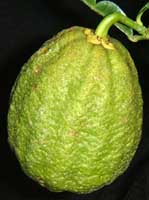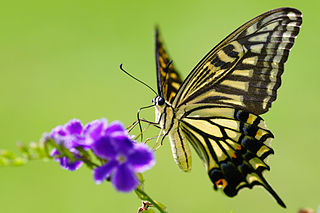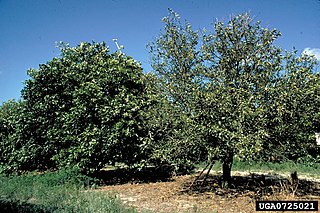
Citrus cavaleriei, the Ichang papeda, is a slow-growing species of papeda that has characteristic lemon-scented foliage and flowers.

The trifoliate orange, Citrus trifoliata, is a member of the family Rutaceae. Whether the trifoliate oranges should be considered to belong to their own genus, Poncirus, or be included in the genus Citrus is debated. The species is unusual among citrus for having deciduous, compound leaves and pubescent (downy) fruit.

Menyanthes is a monotypic genus of flowering plants in the family Menyanthaceae containing the single species Menyanthes trifoliata. The North American form is often referred to as M. trifoliata var. minor Michx. It is known in English by the common names bogbean and buckbean.

The Botanical Garden of the University of Vienna is a botanical garden in Vienna, Austria. It covers 8 hectares and is immediately adjacent to the Belvedere gardens. It is a part of the University of Vienna.

Tiarella, the foamflowers, is a genus of flowering plants in the family Saxifragaceae. The generic name Tiarella means "little turban", which suggests the shape of the seed capsules. Worldwide there are seven species, one each in eastern Asia and western North America, plus five species in eastern North America. As of October 2022, the taxonomy of Tiarella in eastern North America is in flux.
Chinese orange may refer to:

Papilio xuthus, the Asian swallowtail, Chinese yellow swallowtail, Japanese Swallowtail, or Xuthus swallowtail, is a yellow-colored, medium to large sized swallowtail butterfly found in northeast Asia, northern Myanmar, southern China, Taiwan, the Korean Peninsula, Japan, Siberia and the Hawaiian Islands. The butterfly has been observed thrice in New Zealand. Once in Dunedin in 1996 emerging from a chrysalis in a car yard specializing in Japanese used cars; it is thought the chrysalis arrived through one of the cars. and later in Auckland in 2011 and 2016. It was also recorded in the state of Arunachal Pradesh, India, in 2014.
The Jardin botanique de la Faculté de Pharmacie, more formally the Jardin de la Faculté des Sciences Pharmaceutiques et Biologiques de l'Université de Lille 2, is a botanical garden and arboretum operated by the Faculty of Pharmacy of the Université de Lille 2. It is located at 3 Rue du Professeur Laguesse, Lille, Nord, Nord-Pas-de-Calais, France, and open weekdays except university holidays; an admission fee is charged.
The reverse northern blot is a method by which gene expression patterns may be analyzed by comparing isolated RNA molecules from a tester sample to samples in a control cDNA library. It is a variant of the northern blot in which the nucleic acid immobilized on a membrane is a collection of isolated DNA fragments rather than RNA, and the probe is RNA extracted from a tissue and radioactively labelled. A reverse northern blot can be used to profile expression levels of particular sets of RNA sequences in a tissue or to determine presence of a particular RNA sequence in a sample. Although DNA Microarrays and newer next-generation techniques have generally supplanted reverse northern blotting, it is still utilized today and provides a relatively cheap and easy means of defining expression of large sets of genes.

Papilio macilentus, the long tail spangle or maculaturoviy macilentus's swallowtail, is a butterfly of the family Papilionidae. The species was first described by Oliver Erichson Janson in 1877.

Cold-hardy citrus is citrus with increased frost tolerance and which may be cultivated far beyond traditional citrus growing regions. Citrus species and citrus hybrids typically described as cold-hardy generally display an ability to withstand wintertime temperatures below −5 to −10 °C. Cold-hardy citrus may be generally accepted 'true' species or hybrids involving various other citrus species. All citrus fruits are technically edible, though some have bitter flavors often regarded as unpleasant, and this variability is also seen in cold-hardy citrus fruits. Those listed as "inedible fresh" or "semi-edible" can be cooked to make marmalade.
P. trifoliata may refer to:

Citrus taxonomy refers to the botanical classification of the species, varieties, cultivars, and graft hybrids within the genus Citrus and related genera, found in cultivation and in the wild.
Citrus rootstock are plants used as rootstock for citrus plants. A rootstock plant must be compatible for scion grafting, and resistant to common threats, such as drought, frost, and common citrus diseases.
Citrumelo is also called Swingle citrumelo trifoliate hybrid, because it is cold hardy and is a hybrid between a 'Duncan' grapefruit and a trifoliate orange, developed by Walter Tennyson Swingle.
Japanese bitter orange may refer to:

Citrus blight is a type of blight that occurs in tropical and semi-tropical regions. Specializing in infecting citrus trees, the blight is found in North America, the Caribbean, South America, South Africa and Australia. The blight injures plants by forming blockages in xylem and phloem, inhibiting resource distribution and resulting in plant die-back and smaller fruit yields. As of 2020 there is no cure for the blight, and neither the causal agent nor spreading mechanism is known.










